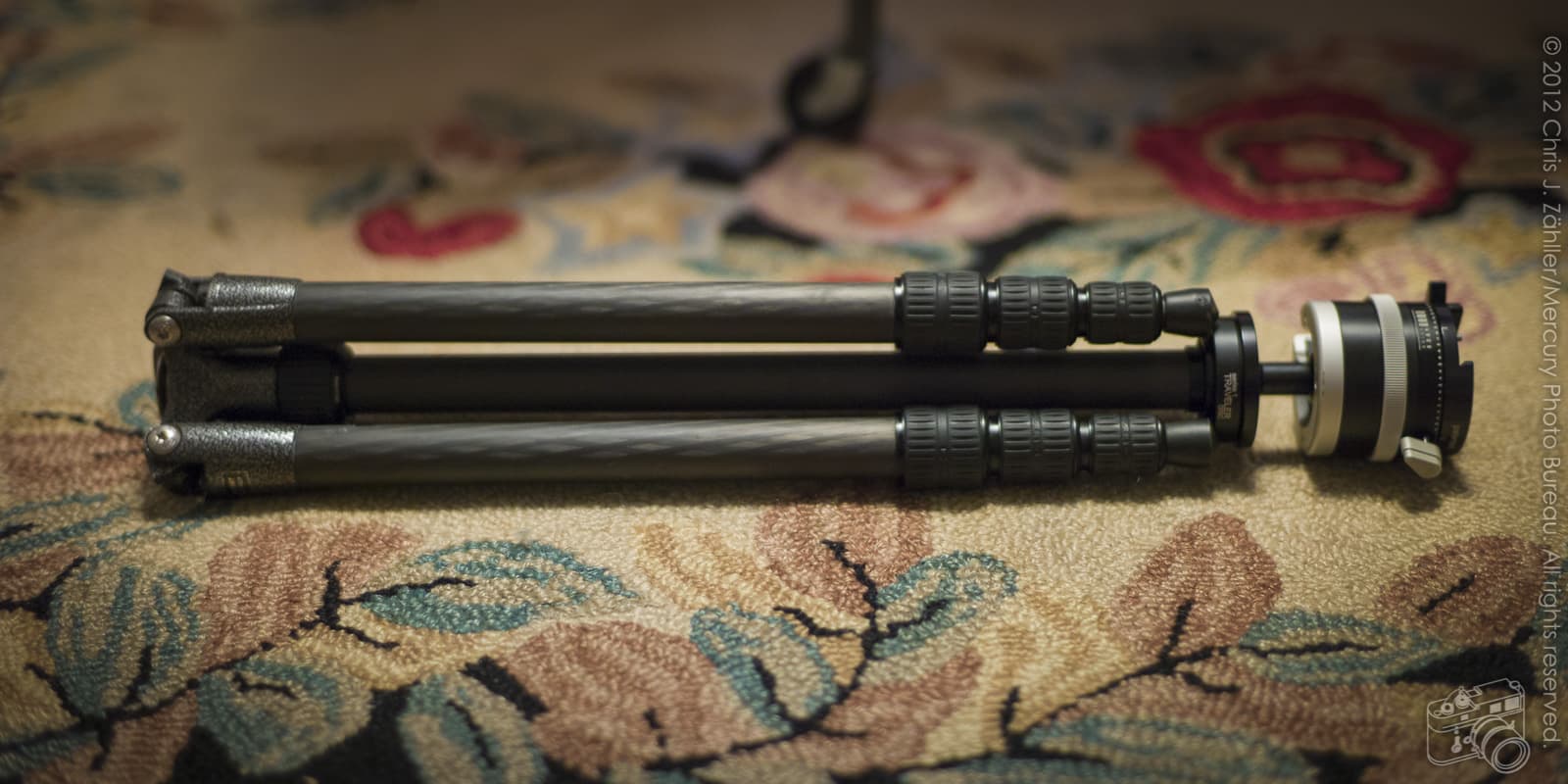
Hands on with the Arca-Swiss P0 Tripod Head Panning System & SlideFix QS Quick Release
Overview
- Street price
- $295 USD
- Manufacturer No.
- 801-213
- Rating
- 4.0 out of 5.0 stars
[Sidenote: Since this article posted, Arca-Swiss have addressed some of the compatibility issues we noted with the release of the Monoball P0 Ballhead with Classic Quick Release (MFR. No. 801-214, $348.00 USD) and the Monoball P0 with Fliplock Quick Set Device (MFR. No. 801-215, $372.00 USD). Our current recommendation is for either of these models in preference to the model reviewed here.]
The Arca-Swiss Monoball P0 Tripod Head, retailing for $295 USD, features a knobless tripod head with a three-element geared locking system. To tilt, rotate the knurled band counter-clockwise (looking down) about a quarter turn: the more you loosen it, the less resistance the gears provide, allowing a tilt range of about 30° from horizontal in any direction. A slot on the side opposite the panoramic release lock allows a full 90° tilt from horizontal. The asymmetrical design of the gears prevents the head from flopping over by increasing resistance the farther the head travels from horizontal.
Size & Weight
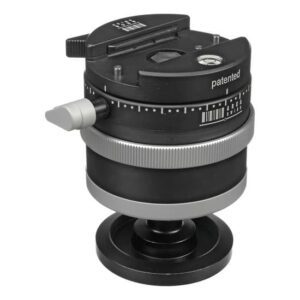
The Monoball P0 head is heavier than the documentation claims; with the SlideFix Quickset (QS) clamp, it totals 12 oz or 340 g. Adding it to my Gitzo GT1542T Series 1 Traveler yields a combined weight of 2.95 lbs or 1.3381 kg, a respectably light kit for travel.
The Monoball P0 head and SlideFix clamp are compact, with a combined height of 3.15″ (80 mm) and a diameter of 2.36″ (60 mm).
The Monoball P0 head is rated at 44.1 lbs (20 kg) capacity.
Deployment
The Monoball P0 head attaches to a standard 3/8″ (.375″ or 9.525 mm) coarse thread (16 tpi) tripod screw. My tripod has a reversible stud with the 2 standard sizes (.25″ and .375″), so mounting is as simple as fitting the head over the stud and tightening clockwise. A single-bubble spirit level on top aids leveling; mounting a camera to the head partially blocks the the level’s visibility, limiting its usefulness.
Attaching a camera equipped with a compatible QS quick release (QR) plate is simple. Assuming you’ve mounted the QR plate to the camera tripod socket with the dovetails facing the camera front and back,
- Pull the locking lever all the way out (fig. 1) — it’s spring loaded, so releasing it will cause it to snap into the “slide” position (as shown in step 4)
- Insert the front plate edge against the SlideFix clamp’s front slot (opposite the locking lever) while angling the rear edge up (fig. 1)
- Lower the rear edge into the slot & release the locking lever (fig. 2)
- Gently adjust the camera by sliding it laterally until you are satisfied with its position, e.g., centered over the Monoball P0 head (fig. 2)
- Push the locking lever in to secure the camera fully; you will feel & hear a gentle snap (fig. 3)
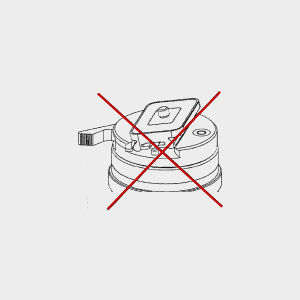
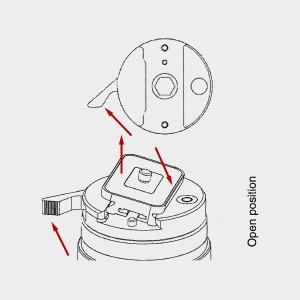


- Tip
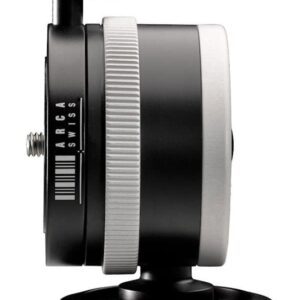
A small flip knob on the panoramic QS device unlocks it for panning. Flip up (counter-clockwise) to release, pan, then flip down to lock. Clearly marked indices aid setting a precise panning position. Because the panning plate is on top and the ball is on the bottom, you don’t have to level the tripod legs when shooting panoramas: just level the head and pan.
To tilt the Monoball P0 head up to 30° in any direction, loosen the knurled locking ring (counter-clockwise), adjust tilt, then tighten the ring. As the tilt angle increases, the planetary gears increase resistance to prevent accidental movement from gravity.
Tilting a full 90° is possible only in the opposite direction from the panoramic lock lever. While one may orient the camera for portraits this way, it’s far from ideal. The camera is not centered over the tripod when oriented 90°, increasing the chance that the rig will tip over. Also, one cannot pan horizontally when oriented 90°, and the spirit level is rendered useless in this position.
When fully collapsed, my Gitzo tripod with the Monoball P0 head attached barely fits in the tripod’s cloth bag. When travelling, the Monoball P0 head should be locked to prevent it flopping about; protecting the Monoball P0 head with a padded lens pouch or a sock is a good idea. I like the Micro Lens Pouches by Cheaplights, available at Amazon.
Care & Maintenance
The Arca-Swiss Monoball P0 head should be cleaned only with a soft cloth dampened with pure alcohol. The manufacturer recommends you protect it from sand and dust, and warns against employing lubricants.
Accessories
Arca-Swiss offers several “L” brackets to solve the problems associated with 90° orientation, albeit at a stiff price: the general purpose bracket, No. 802-308, retails for $229 USD and fits most cameras, while the Mini “L” Bracket, No. 802-304, sells for $239 USD and fits smaller cameras, including many point-and-shoots and rangefinders (including Leica’s M range). A bracket specifically tailored to fit Sony NEX3 and NEX5 cameras sells for $200 USD.
QR plates are offered in a range of sizes, including No. 802-262, designed especially for Leica models M3 – M7, which have their tripod mount sockets located on the far right end. This plate is incompatible with the M8 and the M9; their sockets are located near the camera base plate’s center.
Also incompatible (with the SlideFix clamp, not the Leica cameras) are Arca-Swiss’s “Classic” QR plates; only those plates with the designation “Fix” or “SlideFix” fit the QS QR clamp, a serious bummer for photographers who already own older Arca-Swiss gear. The smaller Fix QS plates are backward compatible with some “Classic” Arca-Swiss QR clamps with a “stepped” slot to accept the wider “Classic” plates as well as the narrower QR plates.
Adding to the confusion is a lack of consistent nomenclature. The names “Fix” and “SlideFix” are used interchangeably by the manufacturer and retailers.
Also available are bench rails and carriers for macro work, an angled connection for building your own custom bracket, and various accessory clamps.
Since it’s a ball head, the Monoball P0 head is not the best choice for a monopod; stick to a tilt head in that case. Really Right Stuff recommends the inexpensive Manfrotto 234 Tilt Head ($24.00 USD) for mounting gear up to 5.5 lbs. to their monopods; the RRS BH-30 gets high marks from users for heavier loads.
Build
The Arca-Swiss Monoball P0 Tripod Head Panning System with SlideFix QS Quick Release is solidly machined from all metal parts, with the superior precision you’d expect from Arca. Slight “play” in the knurled locking ring is, according the the manufacturer, needed for proper function, and is not a defect.
Ergonomics, apart from the inconvenient placement of the spirit level and the aforementioned shortcomings when orienting the camera for portraits, are spot on, with the few controls thoughtfully placed and easy to operate. Positioning accuracy is limited by the fact that it is a ball head; for very precise work, a fully geared head, such as Arca’s top-of-the-line C1 Cube or any of the Manfrotto geared heads, might be more appropriate.
Summary
- Pros
- Lightweight & compact; perfect for travel
- Relatively inexpensive for Arca-Swiss; competitively priced to comparable products from other manufacturers
- Anti-drop design of planetary gears could save expensive accidents
- No protruding knobs or handles (except for very small panoramic release lock)
- Monoball P0 Head stays level during panning
- Easy to operate
- Precision build & top-quality materials
- Large ecosystem of compatible accessories
- Cons
- Not compatible with older Arca-Swiss plates
- Not compatible with most third-party plates & accessories, including RRS, Kirk & Benro
(but you can replace the clamp w/ a compatible alternative, e.g., a Quickset Device Classic)It turns out you cannot replace the clamp, because it is permanently affixed. - Spirit level hard to see when camera mounted; useless at 90° tilt
- Requires expensive “L” bracket for hassle-free portrait mode
- Not appropriate for heavy kits
- Not appropriate for monopods
- Care must be taken not to damage the Monoball P0 head; it is precision equipment!
The Monoball P0 head is well built and designed, attractively priced, and versatile. I highly recommend it for photographers looking for a light, compact, general purpose head to mount to a tripod (but not a monopod). Budget in the “L” bracket, too, as the head’s performance is hampered without it.